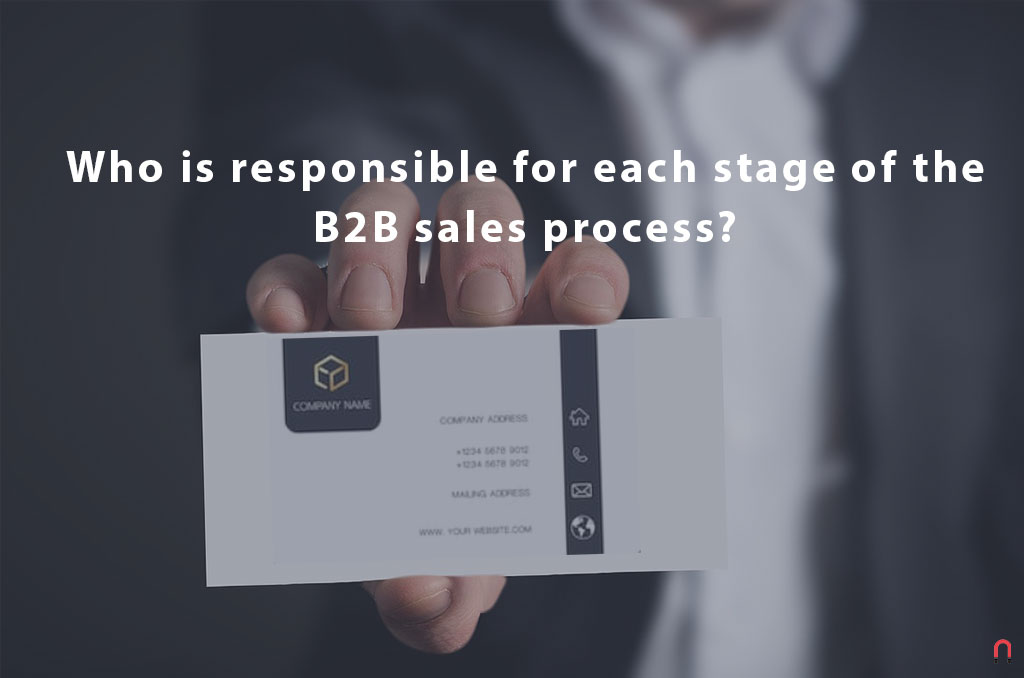Who is responsible for each stage of the B2B sales process?
 Mar 23, 2019 - Marcel Odena
Mar 23, 2019 - Marcel OdenaIt’s hard to improve something you haven’t measured. In the marketing and sales industry, as in many other sectors, dozens of metrics have been defined to measure the performance of an activity and analyze ways to improve it. Boosting sales is normally one of the primary metrics a company will focus on. Starting with the CEO (and we love it when we see more female CEOs, by the way) and continuing with the sales and marketing director, many employees within a B2B company face the never-ending challenge of improving sales, each from their own field of expertise. Investors are eager to see the start-ups they’ve invested in grow and sales are the cog that keeps the machine turning over. More sales, more income, more investment, greater company credibility. It’s that simple.
Divide and Conquer also applies to sales
In order to increase our sales, we must understand the process that proceeds a sale because a potential buyer’s data is only obtained once a contract has been signed. The precise B2B sales process is usually unique to each company. Nevertheless, we can find a common denominator of the steps that many companies follow. As we explained in the article The phases of the B2B sales process, there are usually five clear stages to consider:
- Leads: the contact details of potential buyers.
- Sales Accepted Leads (SALs): these come from the previous leads and are those that exceed the stipulated criteria to start a sales process.
- Meetings (demos): get one of the potential buyer’s contacts to present the product, make a product demonstration, clarify doubts, and present a sales pitch.
- Opportunities: the number of commercial proposals that are delivered to potential buyers.
- Sales: the contracts obtained that result in a one-off sale or a recurring income stream, the latter of which is common in the majority of SaaS (Software as a Service) companies.
How to increase B2B sales
If we want to increase sales, we will have to expand each of the previous metrics. This requires two points of improvement:
- Maximize the number of leads: the more leads we get, the more “raw material” we introduce in this imaginary “sales funnel.” Therefore, the more sales we achieve at the end of the process.
- Maximize the conversion rates between each phase of the sales process. If we manage to improve the conversion rates from Leads to SALs, from SALs to Meetings, from Meetings to Opportunities, and from Opportunities to Sales, we’ll substantially improve our sales overall. Improving conversion rates involves analyzing our data to diagnose why specific leads don’t become SAL, why we aren’t closing meetings for certain SALs, why some meetings don’t generate opportunities, and why we lose certain opportunities as they don’t convert to sales. All that information needs to be turned into ideas; which result in actionable improvements that can be applied to each phase of the process. Apply these actions and then re-measure the rates. Have we improved on last month? If so, we’ve chosen the right improvement actions. If not, it’s back to the drawing board.
The people in charge of each stage of the B2B sales process
We know what each phase of the sales process consists of, and we know we must maximize the conversion rates of each stage. However, there is still one unknown that must be clarified: The person in charge of optimizing the results of each phase of the sales process.
As the famous quote by Napoleon goes: “If you want something done, you need to put someone in charge.” To put it the other way around, if we don’t know who’s in charge of each phase, the process will undoubtedly be difficult to improve.
“If you want something done, you need to put someone in charge. If you want something to be delayed forever, name a commission.” – Napoleón Bonaparte
Therefore, it’s essential to assign a person in charge of each phase of the sales process.
The person in charge of acquiring leads
The task of generating leads can fall under the responsibility of both the sales department and the marketing department. As we have explained in the article “Strategies for generating more leads” there are two excellent strategies we can use:
- Outbound strategy: the person in charge of sales, which is the sales director. There are several different tactics to generate leads such as buying contact lists, researching people who meet the desired profile through tools (such as Linkedin Sales Navigator), attending fairs, and handing out business cards, etc. The problem with this strategy is that the majority of the leads obtained are “cold.” Therefore, the conversion rates from leads (SAL) to meeting/opportunity tend to be low. Furthermore, it can be challenging to scale up the volume of monthly leads with these techniques.
- Estrategia inbound: the person in charge of Marketing, which is the Marketing Director. The philosophy of Inbound Marketing is to attract our audience by generating quality content that they’re interested in, and then obtaining leads as they consume our content. This technique can be enhanced by combining pay-per-click (PPC) advertising techniques, thus managing to scale up the volume of leads achieved each month. Furthermore, we can “warm up” our leads through lead nurturing techniques.
Many companies have a “sourcer” or department of “sourcing” that is basically in charge of discovering other companies with specific characteristics that make them ideal potential buyers. In this case, the sequence is as follows: first, we find potential buyers, and then we try to obtain leads from those companies, either from sales research through tools like LinkedIn Sales Navigator or by using Account Based Marketing techniques.
The person in charge of acquiring SALs
This is the same as the previous section. If the department in charge of generating leads for the company is marketing, then obviously the responsibility for acquiring Sales Accepted Leads would fall on them as well. The criteria must be formalized so that a lead can be considered suitable for the sales process (Sales Accepted Lead). I even recommend putting it into writing so that all parties (marketing and sales) are on the same wavelength. Once the criteria have been clearly spelled out, the marketing department will be in charge of generating SALs.
If marketing gets 100 leads of which only half are suitable for the sales process (SAL) that means the lead to SAL conversion rate is 50%. If marketing asks for 200 SALs each month, then it has to generate 400 leads per month because only half (50% rate) become SAL. From here, marketing can consider putting more effort into creating leads and/or can focus on leads with a more desirable professional profile to improve the conversion rate.
The person in charge of setting up meetings
The person in charge of setting up meetings is usually the Sales Development Representative (SDR). This position is a sales role that’s mainly responsible for turning Sales Accepted Leads (SALs) into meetings. Through various techniques such as email and phone contact, the SDR attempts to contact the lead to offer a meeting in which they can better explain the product, make a product demonstration, and clarify doubts, etc.
The main KPIs of an SDR is the number of meetings they get per month. Getting a “yes” from a potential buyer is not an easy task. A lot of professionalism and a particular artistic method is required to achieve this objective.
The person in charge of generating opportunities and sales
The person responsible for creating opportunities and closing sales is usually the Business Development Manager (BDM). This professional usually has a more senior profile than the SDR. Their mission is to convert a meeting with a prospect into the delivery of a commercial proposal.
If a BDM has ten meetings in a week and manages to convince six of those prospects to consider a commercial offer, then we are talking about a meeting to opportunity conversion rate of 60%.
Likewise, if a BDM delivers 30 commercial proposals in a month and gets ten sales, then we’re talking about an opportunity to sales conversion rate of approximately 33%.
Notice how everything follows a chain in the sales process. Improving the conversion rate from one phase to another increases the chance of generating a sale at the end of the process.
The responsibility of the cross-product
We could have the best marketing team and the best sales team in the world, but if the product we’re selling isn’t competitive, we’re not going to get the amount of sales we want. Product is king. Although not only the product, for we must also consider its context and customer service as key factors.
From my point of view, it’s crucial to identify which parts of the sales process fail due to product-related reasons. That way, all the sales related aspects can be collected and fed back into the system as a whole.
- If there is some functionality that the prospects put as a condition to buy, it must be taken into account. If the price model doesn’t fit with the expectation of some prospects, this must also be considered.
- Tasks may arise for both the product team and the sales and marketing departments in the previous exercise. It’s possible some of the missed sales are because our product doesn’t align with the prospect’s profile. Having this analysis at hand will allow marketing to improve the lead capture process, do better segmenting, and send a message that is more focused on the profile of the buyer persona, etc.
Conclusion
Understanding what follows the B2B sales process is crucial to improving sales. But it is not enough in of itself. We must also identify who is in charge of each stage of the sales process within the company. Setting clear goals for each manager of each process with objective evaluation criteria will allow you to measure the sales achieved each month and the conversion rates from one phase to another. This will let you analyze what causes lost opportunities from unqualified leads, etc. In turn, you’ll be able to identify improvement actions in each stage of the process. You can’t improve what hasn’t been measured. Therefore, you have to measure and you have to appoint managers to ensure each metric of the sales process is being improved.
Related articles
- The phases of the B2B sales process
- Basic concepts about B2B lead generation
- Account Based Marketing techniques to generate leads for qualified companies
- Best practices for Inbound Marketing
- 5 examples of LinkedIn Campaigns for generating quality sales leads
Feel free to leave your comment below:



